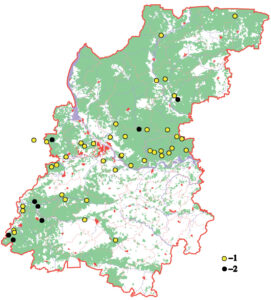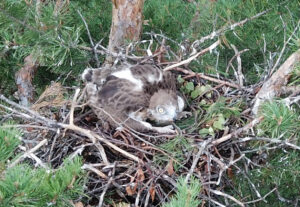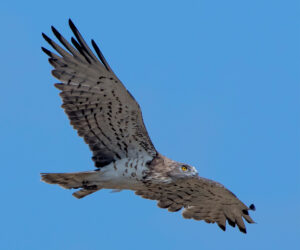Third International Scientific and Practical Conference “Eagles of the Palearctic: Study and Conservation”
Raptors Conservation. Suppl. 2. Proceedings of Conferences
Current data on Short-toed Eagle in the Nizhny Novgorod Region, Russia
Shukov P.M. (Nizhny Novgorod Branch of the Russian Bird Conservation Union; Ecocenter “Dront”, Nizhny Novgorod, Russia)
Contact:
Pavel Shukov shukov.pm@gmail.com
Recommended citation: Shukov P.M. Современные данные о змееяде в Нижегородской области, Россия. – Пернатые хищники и их охрана. 2023. Спецвып. 2. С. 80–83. DOI: 10.19074/1814-8654-2023-2-80-83 URL: http://rrrcn.ru/en/archives/34894
The article presents current results of a study of Short-Toed Eagle (Circaetus gallicus) distribution, abundance, and ecology in Nizhny Novgorod region.
We designed a network of auto routes to survey the area and subsequently covered it in a four-wheel drive vehicle combined with walking through upland bogs and forest margins by foot. Observations were carried out in 30 districts of the region. Hunting Short-Toed Eagles were observed from natural hills through binoculars. Nests were detected based on adult birds’ observations and analysis of satellite images of the surveyed areas. Photo and video recording of birds and nests was carried out using a SLR camera and a quadcopter.
In 2015–2023 observations were carried out on 49 breeding territories.
A combination of various swamps, burnt areas, and clearings (n=19; 39%) and typical upland bogs associated with pine forests (n=16; 33%) are optimal biotopes for ShortToed Eagle. However, Short-Toed Eagle occupies both floodplain meadows (n=7; 14%) and fallow lands (n=5; 10%) in the Nizhny Novgorod region, provided that these biotopes are combined with pine forests. Breading territories are least likely to be located in depleted peat quarries (n=2; 4%).
Due to peculiarities of the species ecology (vast breeding territories and nests that are difficult to detect), not a single nest was found in the region until 2016. Currently Short-Toed Eagle breeding has been reliably confirmed on eight breeding territories. We found nine nests located on pines. Variants of nest location architectonics are the following: in the upper whorl of a flattened crown (n=6), on side branches in the central part of the crown (n=2), on the “witch's broom” at the top of the tree (n=1). Reproduction timing is recorded from April 20 (the earliest date of egg laying) to August 10 (nestling remains in the nest). Short-Toed Eagle tends to change nests every season. The repeated reproduction in the same nest was recorded for one pair only, and both attempts were unsuccessful. Only Common European vipers and Grass snakes were reliably identified among the prey brought to the nest (n=24). We repeatedly noted neighbouring pairs interacting at borders of breeding territories, furthermore, we observed Short-Toed Eagles’ conflicts with Common Buzzard (Buteo buteo) (n=6) and Greater Spotted Eagle (Aquila clanga) (n=1).
We were able to draw conclusions based on the results of long-term observations on a typical elliptic shape of a Short-Toed Eagle breeding territory with the nest located in one of its focuses. The main route birds took from the nest to hunting grounds runs along the major axis of the ellipse. Short-Toed Eagles hunt in the immediate vicinity of the nests only in bad weather conditions or in case of unsuccessful breeding, when long flights for prey become rare. The longest recorded distance a hunting bird travelled from its nest was 7.2 km. The shortest distance between two neighboring nests is 3.9 km.
The current Short-Toed Eagle abundance in the Nizhny Novgorod region is estimated at 80–90 breeding pairs, which is about five times higher than the estimate of the abundance given in the Red Data Book of the Nizhny Novgorod region in 2014. This increase is affected less by the actual dynamic in the number of species because of changes in habitats (formation of extensive burnt areas and overgrown fallows) and more due to special research efforts.
We can assume that estimates of the Short-Toed Eagle population in areas adjacent to the Nizhny Novgorod region were repeatedly undervalued.
Given the specifics of ecology (stenophage species, consumer of the 3rd–4th order, low breeding potential, the highest size class), this species continues to require increased attention and preservation of a high conservation status.

Breeding territories of the Short-Toed Eagle (Circaetus gallicus) in the Nizhny Novgorod region: 1 – probable nesting, 2 – confirmed nesting.



